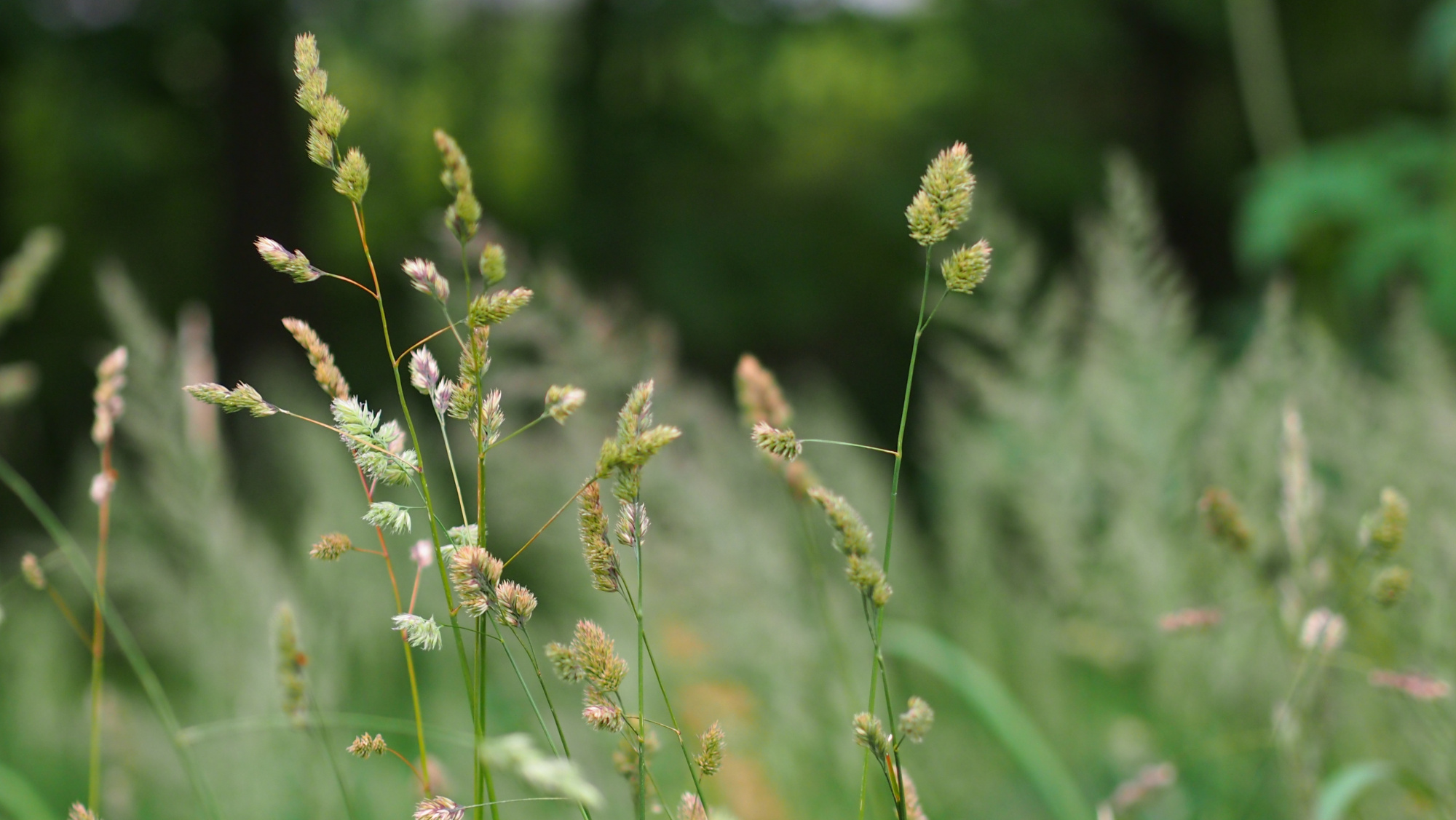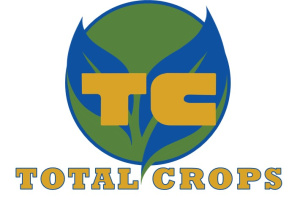News and Events
Mixed outcomes from the 2021 corn harvest for silage
Posted On: November 22, 2021
By Dr. John Goeser, PAS, Dipl. ACAN, Rock River Laboratory, Inc., UW-Madison, animal and dairy sciences
 There were two common themes to 2021 in growing corn for silage: continued variation in growing conditions and plenty of heat units.
There were two common themes to 2021 in growing corn for silage: continued variation in growing conditions and plenty of heat units.
And over the last few years, variation seems to be the only consistent factor. In 2018 and 2019, wet spring or wet fall contributed toward more variation. Now with the 2021 growing season in the books for silage, the crop looks to be yielding variable outcomes, depending on your local growing conditions.
Coming back to the heat this year, with more than adequate growing degree days throughout the year, our focus turned to much needed rainfall and moisture for many. Moisture eventually came while many corn fields were in the grain filling period, but after the crop had been stressed for water while in the vegetative stage. This recap becomes important because I’m of the opinion that the early season moisture stress coupled with adequate heat and moisture during grain fill yielded a unique corn silage crop that now sits fermenting in silos.
To paint a picture with this unique crop, we need to drill back into what defines corn silage quality. In the past, I’ve described that corn silage energy value can be largely explained by the digestible fiber and starch fractions, which combine to make up roughly 85% of corn silage’s energy value. To drill into digestible fiber and starch, we need to pull the following four values from your feed analysis reports:
- Fiber content, % of dry matter
- Fiber digestibility, % of fiber
- Starch content, % of dry matter
- Starch digestibility, % of starch
With these four in hand, I review fiber and starch content first, and then the respective nutrient digestibilities next. Following this path to understand crop quality, the following figures summarize crop year results for thousands of corn silage analyses from Rock River Laboratory. These distribution reports detail the unique 2021 crop and compare to prior crop years.
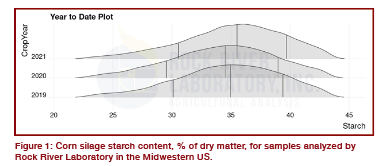 Despite drought stress to start 2021, starch yields are trending at similar levels relative to the prior two growing seasons. Starch content is a result of the grain to stover ratio, and grain yield came forth following rain as mentioned. Hence, similar starch levels detailed in Figure 1 for this year’s crop aren’t surprising. Along these lines, as visible in Figure 2, corn silage fiber levels are similar to prior crop years due to the fact that stronger than anticipated grain yields have diluted out the stover and fiber. These two observations aren’t unique.
Despite drought stress to start 2021, starch yields are trending at similar levels relative to the prior two growing seasons. Starch content is a result of the grain to stover ratio, and grain yield came forth following rain as mentioned. Hence, similar starch levels detailed in Figure 1 for this year’s crop aren’t surprising. Along these lines, as visible in Figure 2, corn silage fiber levels are similar to prior crop years due to the fact that stronger than anticipated grain yields have diluted out the stover and fiber. These two observations aren’t unique.
The uniqueness to the 2021 silage crop begins showing up in the fiber and starch digestibility measures at Rock River Laboratory. Fiber quality and digestibility for corn likely determined early in the growing season, while the plant is growing and in a vegetative state. Remembering that the crop was stressed 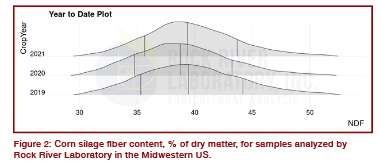 for moisture through that phase this year, the higher quality fiber visible in Figure 3 may make some sense. In Figure 3, the University of Wisconsin’s total tract NDF digestibility (TTNDFD) measure suggests more digestible fiber in 2021 silage. This TTNDFD value is determined from four different laboratory fiber digestibility measures on each sample, and has been useful in predicting feeding quality for various forages. The goal with this measure is 45 percent or more, and this year is trending in that direction. For each unit improvement in silage TTNDFD, milk production may increase roughly ¾ pound per cow, per day, according to a field survey and experience summarized by Geiser and Goeser (2018).
for moisture through that phase this year, the higher quality fiber visible in Figure 3 may make some sense. In Figure 3, the University of Wisconsin’s total tract NDF digestibility (TTNDFD) measure suggests more digestible fiber in 2021 silage. This TTNDFD value is determined from four different laboratory fiber digestibility measures on each sample, and has been useful in predicting feeding quality for various forages. The goal with this measure is 45 percent or more, and this year is trending in that direction. For each unit improvement in silage TTNDFD, milk production may increase roughly ¾ pound per cow, per day, according to a field survey and experience summarized by Geiser and Goeser (2018).
While fiber quality may be improved, the grain may be negatively offsetting the positive energy value 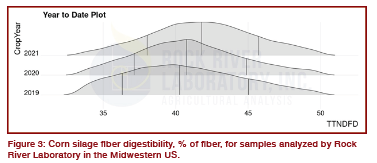 rooted in fiber. Adequate moisture and above average heat units to wrap up the 2021 growing season appear to have yielded harder grain this year. Think of this like the corn plant having plenty of resources to produce strong offspring, the grain. Rumen grain and starch digestibility is known to correlate strongly with grain and kernel hardness, and the laboratory is clearly picking up on lesser rumen starch digestibility in 2021 silage, as shown in Figure 4. Understanding that rumen starch digestibility is down for 2021 silage relative to the prior two years, keep this in mind when opening up new crop silage. Watch for silage grain passing through undigested.
rooted in fiber. Adequate moisture and above average heat units to wrap up the 2021 growing season appear to have yielded harder grain this year. Think of this like the corn plant having plenty of resources to produce strong offspring, the grain. Rumen grain and starch digestibility is known to correlate strongly with grain and kernel hardness, and the laboratory is clearly picking up on lesser rumen starch digestibility in 2021 silage, as shown in Figure 4. Understanding that rumen starch digestibility is down for 2021 silage relative to the prior two years, keep this in mind when opening up new crop silage. Watch for silage grain passing through undigested.
Combining the observations discussed above, fiber and starch levels are in line with prior crops. Fiber 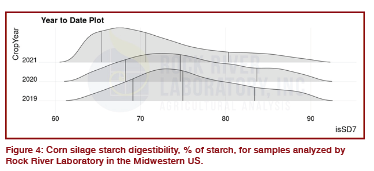 quality looks to be up, while starch quality appears to be down. The net outcome is likely a similar energy value per ton relative to prior crop years, however the contributions to this average energy value are unique this year. The net outcome could be likened to buying a new self-propelled forage harvester, with more horsepower and potential, but filling the tank with marginal diesel that doesn’t burn as well. There’s potential to this year’s crop, however the silage will need to ferment longer to capture the full grain and starch potential assuming we did our job in kernel processing. Contact John at JohnGoeser@rockriverlab.com
quality looks to be up, while starch quality appears to be down. The net outcome is likely a similar energy value per ton relative to prior crop years, however the contributions to this average energy value are unique this year. The net outcome could be likened to buying a new self-propelled forage harvester, with more horsepower and potential, but filling the tank with marginal diesel that doesn’t burn as well. There’s potential to this year’s crop, however the silage will need to ferment longer to capture the full grain and starch potential assuming we did our job in kernel processing. Contact John at JohnGoeser@rockriverlab.com




